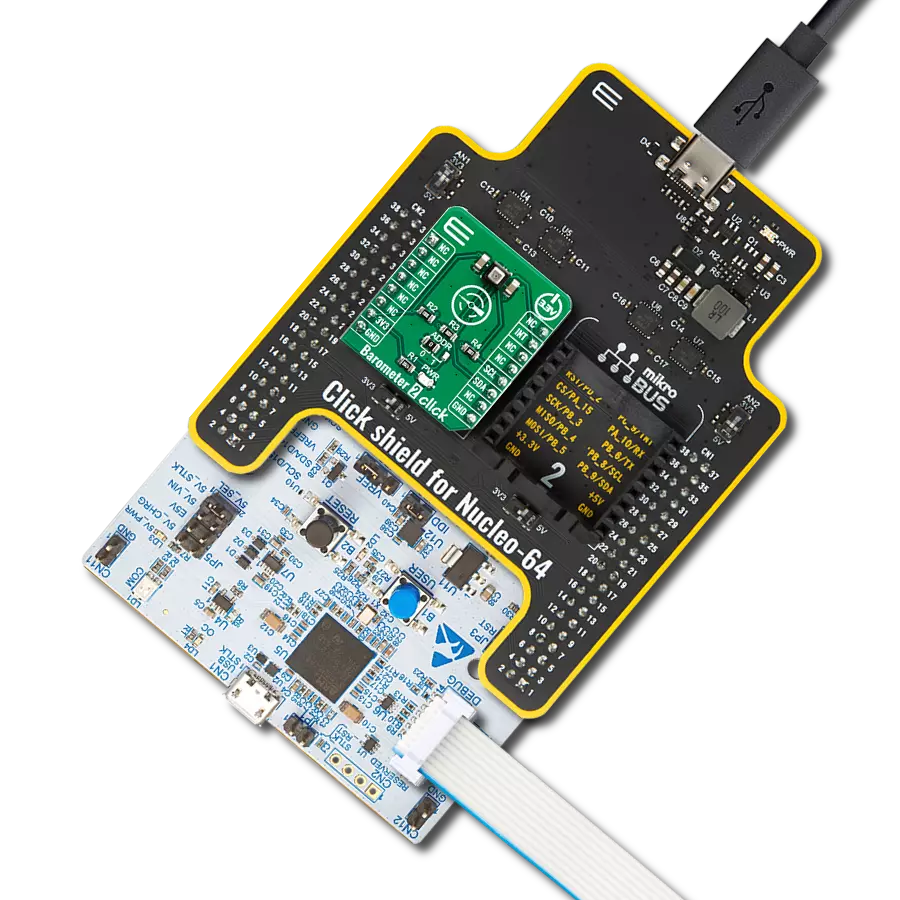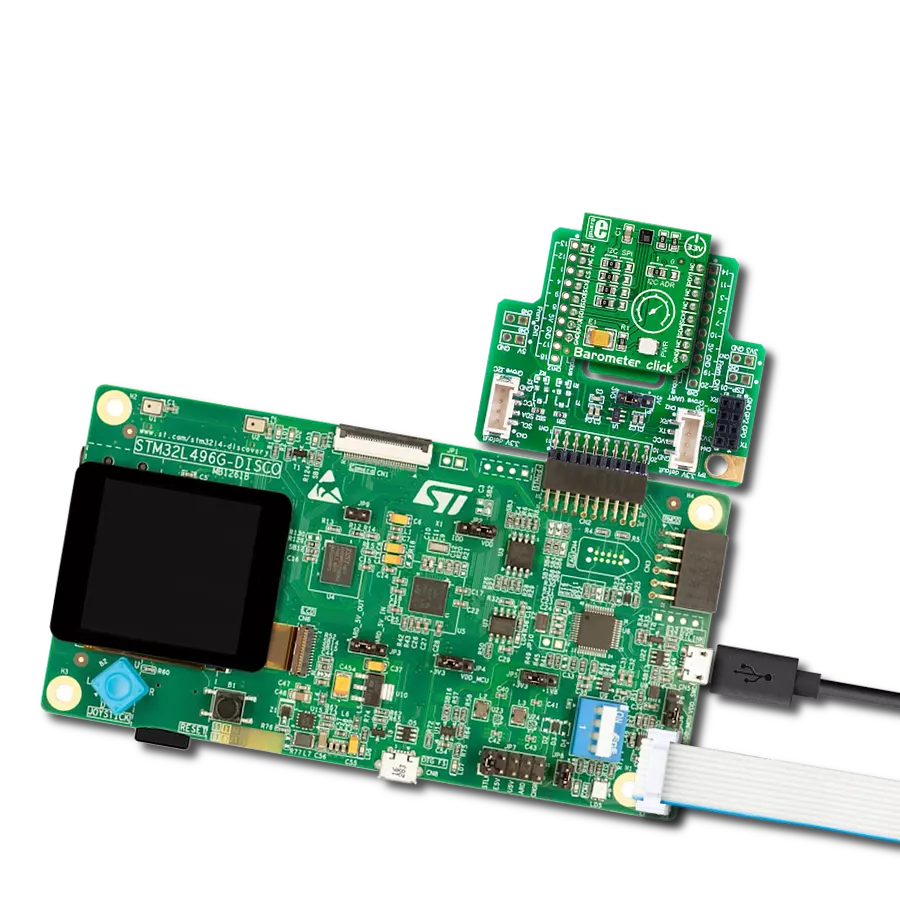Our digital differential pressure sensor is engineered to provide precise and reliable readings for a wide range of applications, from industrial automation to environmental monitoring
A
A
Hardware Overview
How does it work?
VAV Press Click is based on the LMIS025B, a low differential pressure sensor from TE Connectivity that offers a digital output for reading pressure over the specified pressure span. The innovative LMI technology features superior sensitivity, especially for ultra-low pressures ranging from 0 to 25Pa / 0 to 0.25mbar (0.1 in H2O). It is based on thermal flow measurement of gas through a micro-flow channel integrated within the sensor chip. The extremely low gas flow through the sensor ensures high immunity to dust contamination, humidity, and long tubing compared to other flow-based pressure sensors,
including the outstanding long-term stability, precision with patented real-time offset compensation, and linearization techniques. The LMIS025B offers two modes of operation: Continuous mode with a 5ms sampling time, which provides a near-continuous stream of pressure data, and low-power mode with a 400μA Standby current which wakes the device from Sleep to serve pressure data “on-demand”. The first measurement in either mode is available after a warm-up and conversion sequence, which takes approximately 25 ms. VAV Press Click communicates with MCU using the standard I2C
2-Wire interface, offering linearized digital output through a 16-bit sigma-delta A/D conversion. Besides, it also allows the choice of the least significant bit of its I2C slave address by positioning the SMD jumper labeled as ADDR SEL to an appropriate position marked as 0 and 1. This Click board™ can be operated only with a 3.3V logic voltage level. The board must perform appropriate logic voltage level conversion before using MCUs with different logic levels. Also, it comes equipped with a library containing functions and an example code that can be used as a reference for further development.
Features overview
Development board
EasyPIC v7 is the seventh generation of PIC development boards specially designed to develop embedded applications rapidly. It supports a wide range of 8-bit PIC microcontrollers from Microchip and has a broad set of unique functions, such as a powerful onboard mikroProg programmer and In-Circuit debugger over USB-B. The development board is well organized and designed so that the end-user has all the necessary elements in one place, such as switches, buttons, indicators, connectors, and others. With four different connectors for each port, EasyPIC v7 allows you to connect accessory boards, sensors, and custom electronics more efficiently than ever. Each part of
the EasyPIC v7 development board contains the components necessary for the most efficient operation of the same board. An integrated mikroProg, a fast USB 2.0 programmer with mikroICD hardware In-Circuit Debugger, offers many valuable programming/debugging options and seamless integration with the Mikroe software environment. Besides it also includes a clean and regulated power supply block for the development board. It can use various external power sources, including an external 12V power supply, 7-23V AC or 9-32V DC via DC connector/screw terminals, and a power source via the USB Type-B (USB-B) connector. Communication options such as
USB-UART and RS-232 are also included, alongside the well-established mikroBUS™ standard, three display options (7-segment, graphical, and character-based LCD), and several different DIP sockets. These sockets cover a wide range of 8-bit PIC MCUs, from PIC10F, PIC12F, PIC16F, PIC16Enh, PIC18F, PIC18FJ, and PIC18FK families. EasyPIC v7 is an integral part of the Mikroe ecosystem for rapid development. Natively supported by Mikroe software tools, it covers many aspects of prototyping and development thanks to a considerable number of different Click boards™ (over a thousand boards), the number of which is growing every day.
Microcontroller Overview
MCU Card / MCU

Architecture
PIC
MCU Memory (KB)
80
Silicon Vendor
Microchip
Pin count
28
RAM (Bytes)
3328
Used MCU Pins
mikroBUS™ mapper
Take a closer look
Click board™ Schematic

Step by step
Project assembly
Software Support
Library Description
This library contains API for VAV Press Click driver.
Key functions:
vavpress_set_default_sensor_param- VAV Press set default sensor parameter functionvavpress_get_dif_press_and_temp- VAV Press get differential pressure and temperature functionvavpress_retrieve_electronic_signature- VAV Press retrieve electronic signature function
Open Source
Code example
The complete application code and a ready-to-use project are available through the NECTO Studio Package Manager for direct installation in the NECTO Studio. The application code can also be found on the MIKROE GitHub account.
/*!
* @file main.c
* @brief VavPress Click example
*
* # Description
* This library contains API for the Vav Press Click driver.
* This demo application shows an example of
* differential pressure and temperature measurement.
*
* The demo application is composed of two sections :
*
* ## Application Init
* Initialization of I2C module and log UART.
* After driver initialization and default settings,
* the app display retrieve the electronic signature
* and set the sensor parameters data.
*
* ## Application Task
* This is an example that shows the use of a Vav Press Click board™.
* Logs pressure difference value [ Pa ] and temperature [ degree Celsius ] value.
* Results are being sent to the Usart Terminal where you can track their changes.
*
*
* @author Nenad Filipovic
*
*/
#include "board.h"
#include "log.h"
#include "vavpress.h"
static vavpress_t vavpress;
static log_t logger;
static float diff_press;
static float temperature;
vavpress_el_signature_data_t el_signature_data;
vavpress_sensor_param_data_t param_data;
void application_init ( void ) {
log_cfg_t log_cfg; /**< Logger config object. */
vavpress_cfg_t vavpress_cfg; /**< Click config object. */
/**
* Logger initialization.
* Default baud rate: 115200
* Default log level: LOG_LEVEL_DEBUG
* @note If USB_UART_RX and USB_UART_TX
* are defined as HAL_PIN_NC, you will
* need to define them manually for log to work.
* See @b LOG_MAP_USB_UART macro definition for detailed explanation.
*/
LOG_MAP_USB_UART( log_cfg );
log_init( &logger, &log_cfg );
log_printf( &logger, "\r\n" );
log_info( &logger, " Application Init " );
// Click initialization.
vavpress_cfg_setup( &vavpress_cfg );
VAVPRESS_MAP_MIKROBUS( vavpress_cfg, MIKROBUS_1 );
err_t init_flag = vavpress_init( &vavpress, &vavpress_cfg );
if ( init_flag == I2C_MASTER_ERROR ) {
log_error( &logger, " Application Init Error. " );
log_info( &logger, " Please, run program again... " );
for ( ; ; );
}
vavpress_default_cfg ( &vavpress );
log_info( &logger, " Application Task " );
Delay_ms ( 100 );
vavpress_retrieve_electronic_signature( &vavpress, &el_signature_data );
Delay_ms ( 100 );
log_printf( &logger, "--------------------------------\r\n" );
log_printf( &logger, " Firmware Version : %.3f \r\n", el_signature_data.firmware_version );
log_printf( &logger, " Pressure Range : %d Pa \r\n", el_signature_data.pressure_range );
log_printf( &logger, " Part # : %.11s \r\n", el_signature_data.part_number );
log_printf( &logger, " Lot # : %.7s \r\n", el_signature_data.lot_number );
log_printf( &logger, " Output Type : %c \r\n", el_signature_data.output_type );
log_printf( &logger, " Scale Factor : %d \r\n", el_signature_data.scale_factor );
log_printf( &logger, " Calibration ID : %.2s \r\n", el_signature_data.calibration_id );
log_printf( &logger, " Week number : %d \r\n", el_signature_data.week_number );
log_printf( &logger, " Year number : %d \r\n", el_signature_data.year_number );
log_printf( &logger, " Sequence number : %d \r\n", el_signature_data.sequence_number );
log_printf( &logger, "--------------------------------\r\n" );
Delay_ms ( 1000 );
Delay_ms ( 1000 );
param_data.scale_factor_temp = 72;
param_data.scale_factor_press = el_signature_data.scale_factor;
param_data.readout_at_known_temperature = 50;
param_data.known_temperature_c = 24.0;
Delay_ms ( 100 );
}
void application_task ( void ) {
err_t error_flag = vavpress_get_dif_press_and_temp( &vavpress, ¶m_data, &diff_press, &temperature );
if ( error_flag == VAVPRESS_OK ) {
log_printf( &logger, " Diff. Pressure : %.4f Pa\r\n", diff_press );
log_printf( &logger, " Temperature : %.4f C\r\n", temperature );
log_printf( &logger, "--------------------------------\r\n" );
Delay_ms ( 1000 );
Delay_ms ( 1000 );
} else {
log_error( &logger, " Communcation Error. " );
log_info( &logger, " Please, run program again... " );
for ( ; ; );
}
}
int main ( void )
{
/* Do not remove this line or clock might not be set correctly. */
#ifdef PREINIT_SUPPORTED
preinit();
#endif
application_init( );
for ( ; ; )
{
application_task( );
}
return 0;
}
// ------------------------------------------------------------------------ END



































